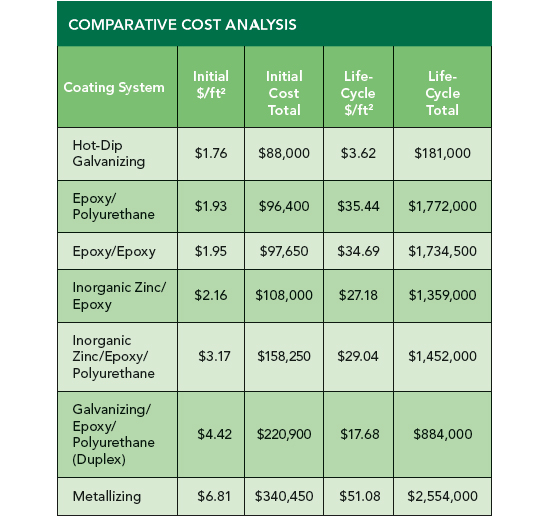Why Galvanize?
Cost
Contrary to the long-standing misconception that hot-dip galvanized steel is cost prohibitive on an initial basis, the process offers savings both in upfront and life-cycle expenses. Technological advancements have made galvanized steel competitive and even less costly than alternative systems.
Using the galvanizing cost data3 obtained through a 2014 survey of North American hot-dip galvanizers and, most importantly, paint cost data taken from paint manufacturers, an online life-cycle cost calculator4 (lccc.galvanizeit.org) was developed that can track comparative costs of various coating systems. Consider the following example that compares hot-dip galvanizing to paint systems, a metallized solution, and duplex system for a hypothetical 50,000-square-foot project—which could represent a bridge, a light rail station, or a stadium—with a 75-year design life in a moderately industrial environment.
The example incorporates first costs of the material, the number of coats required, and the cleaning system, including labor costs. All systems were cleaned to their relevant standards. The figure for galvanizing is an all-inclusive price, as galvanizer quotes include surface preparation, material and labor costs, though not the fabricator mark up which tends to vary widely. A typical mix of structures was used, which may result in galvanizing cost savings over paint, as galvanizing can more efficiently bundle steel elements. Yet even comparing medium or large elements, galvanizing still comes out less expensive or within a few cents per square foot of the alternative systems. Further, as the cost of these alternatives has risen over the past decade, hot-dip galvanizing has shown price stability.
Comparative Cost Analysis
Even when life-cycle costs are considered, hot-dip galvanizing ranks ahead of the other systems. In a comparative analysis5, galvanizing came out as the most cost effective followed by the duplex system, a galvanized plus painted system. The analysis presumed a 75-year lifetime as a realistic timeframe before modification, as opposed to an ideal maintenance cycle that would be far more costly for those systems that require regular maintenance.
The results, also summarized in the accompanying table, are as follows:
• Hot-dip galvanizing—cost increase 105 percent
• Duplex system (galvanizing/epoxy/polyurethane)—cost increase 300 percent
• Inorganic zinc/epoxy—cost increase 1,150 percent
• Inorganic zinc/epoxy/polyurethane—cost increase 818 percent
• Epoxy/epoxy—cost increase 1,675 percent
• Epoxy/polyurethane—cost increase 1,738 percent
• Metallizing—cost increase 650 percent

Hot-Dip Galvanizing: Making Steel Sustainable
While it is a naturally occurring phenomenon, corrosion is costly to repair and can have disastrous effects on the structural integrity of a building. Sustainable, cost-effective corrosion protection systems are critical for all buildings with steel elements, and particularly those in marine or other harsh environments. Hot-dip galvanizing is one such system that has been used for more than a century with maintenance not required for up to 75 years. Traditionally used in such demanding industries as power and petrochemicals, today's architects are using hot-dip galvanizing, and duplex systems that combine this process and paint, to aesthetic effects in buildings of all types, ensuring that they remain durable and visually appealing for decades. As sustainability continues to dominate the global agenda, architects and owners will increasingly rely on solutions like hot-dip galvanizing to meet green building goals within an aesthetic, economical framework.
Endnotes
- American Institute of Steel Construction (AISC). Innovative Solutions in Steel: Open-Deck Parking Structures. 2003.
- Duplex Systems, J.F.H van Eijnsbergen, Elsevier, 1994, p. 7
- KTA Tator, Inc Paper No. C2014-4088 Expected Service Life and Cost Considerations for Maintenance and New Construction Protective Coating Work (2014)
- ASTM A1068-10 Standard Practice for Life-Cycle Cost Analysis of Corrosion Protection Systems on Iron and Steel Products.
- Ibid.
 |
| The American Galvanizers Association is a non-profit trade association that serves as the unified voice of the North American hot-dip galvanized steel industry. The AGA provides architects, engineers, specifiers, fabricators, contractors, and galvanizers technical support on today's innovative applications and state-of-the-art technological developments in hot-dip galvanizing for corrosion control. www.galvanizeit.org |








